Temeraire is a nine-book fantasy series by acclaimed author Naomi Novik, first published in 2006 and completed in 2016. The premise of the series is an alternate history of the Napoleonic Wars, retold in a world populated by a wide variety of dragons, who fight alongside men for their various nations.
The series follows the adventures of the eponymous dragon, Temeraire, and his aviator, Captain William Laurence. In Novik’s imagined world, there is a tight knit relationship between dragons and their human companions (similar to many other popular stories about dragons). Often bonded at birth, dragons are typically devoted to their humans — and the relationship between Laurence and Temeraire lies at the heart of this story.
Note: The following discussion contains some spoilers for the Temeraire series. Read on at your own discretion.
Table of Contents
Imagining a World of Dragons
I’ll admit that when I picked up Temeraire, I was expecting (and half-hoping) for something similar to Bernard Cornwell’s Sharpe series. The Sharpe books were favourites of mine when I was younger. These novels follow soldier Richard Sharpe through the various battles of the Napoleonic Wars and see him rise among the ranks of the British Army.
While I’d hoped for a similar military history angle, Temeraire goes in quite a different direction. For Novik, the main scope of the Temeraire series is to explore the political and cultural implications of a world populated by intelligent dragons — and this exploration provides a fascinating backdrop to the adventures of Laurence and Temeraire.
The great tension of the series is that Temeraire is a dragon-revolutionary, who is opposed (by force of circumstance) to Napoleon — a figure with whom he shares much in common, ideologically. The European world is unjust to dragons. European nations treat them as dumb fighting beasts, to be manipulated with food and treasure. Temeraire arrives as a great enlightening force to break this status quo, much like the events of the French Revolution for humans.
The main story is driven by Temeraire’s idealism, which finds itself often at odds with Laurence’s more pragmatic outlook. Temeraire is forced again and again to find common ground with his beloved captain — although he does frequently drag him into trouble along the way.
The story takes the reader on a tour of the draconic world, from Europe to China (both by land and by sea), then to Africa, Australia, South America, and finally back to Europe. In each continent, we see the different ways that dragons are integrated into cultures like Imperial China, African tribes, Australian aborigines, the Incas, the Turks, the Japanese, and more.
These explorations often reveal new philosophical perspectives on the relationships between humans and dragons, which inform Temeraire’s outlook and guide his actions as the series progresses. The story is deeply moral in character, examining the decisions that Temeraire and Laurence are forced to make — and following this journey is the true joy of the series.
A Classic Fantasy of Manners
One of the hallmarks of the Temeraire series is its ‘fantasy of manners’ elements (similar to the comedy of manners genre), where a lot of the drama and tension arises from the social etiquette in situations — often coinciding with political maneuvering, but not necessarily.
This begins as Temeraire and Laurence are introduced to the Aerial Corps and their different traditions and culture, which is distinct from Laurence’s experience in the navy. This continues to evolve as they visit the various courts of Europe, China, and so on.
Laurence, as a character, is obsessed with his sense of honor and decorum. Often exasperated by Temeraire, who tries his best, but does not entirely understand human conventions, this element of the story is the source of great humour and tension. Suffice to say, if you enjoy ‘fantasy of manners’, you will probably love Temeraire.
Non-Standard, Archaic Style of Punctuation
Another element of the series, which I haven’t often seen discussed, is its non-standard use of punctuation. Novik uses punctuation in a very intentional way throughout the books to evoke the Napoleonic atmosphere.
For example, you find a lot of run-on sentences that are joined with semicolons or commas. Characters often use unnecessarily long-winded or flowery turns of phrase, even when we’re hearing their internal (indirect/non-italicized) dialogue. (Maybe I’ll post examples later.)
I’m sure that more than one person has been put off by these oddities, but they were part of what made the series really charming for me. The style evokes the Napoleonic era in a very effective way and really puts you in the moment.
In particular, these features contribute to the ‘fantasy of manners’ feel of the story and add an almost Jane Austen-style authenticity to the prose. I’ve seen particular dialects or writing styles used by authors before, but never in this particular way — and you have to credit Novik for her originality and confidence to try this approach with a debut series.
The Publication of Temeraire
For me, as a writer, one of the most fascinating things about Temeraire is how the series was published and marketed. Eschewing traditional publishing advice, Naomi Novik completed all three books in the Temeraire series before she had even signed with her first publisher.
Conventional wisdom often suggests debut authors avoid putting ‘all their eggs in one basket’ and write a few manuscripts, so if one book fails they can try submitting another. However, Novik’s approach paid off when she was eventually picked up.
Having three manuscripts ready for editing and publication meant that all three of the Temeraire books went to press within the first year (2006). Major marketing was put behind the books and the series cemented Novik’s reputation as a fantasy author almost immediately, rather than the usual build-up, which can take years or even decades.
This unique approach was discussed on the Writing Excuses podcast, by Brandon Sanderson, Mary Robinette Kowal, Dan Wells, and Howard Taylor, as an alternative approach for new authors — although one that certainly comes with major risks.
While this has little bearing on how one should read or appreciate the series, it is an interesting bit of backstory that I wanted to share. And now, onward to the discussion!
My Temeraire Reviews
In the section below, I’ve provided a quick summary and discussion of each book. If you don’t want spoilers, I’d suggest that you stop reading here — and pick up the first book (His Majesty’s Dragon) instead! If you don’t mind some minor spoilers and you want to learn more about the series (before diving in), please keep going!
The Temeraire Series was published in chronological order and should be read in the same. As a quick summary, here are my personal rating for all nine books:
- His Majesty’s Dragon (2006) — S Tier
- Throne of Jade (2006) — B Tier
- Black Powder War (2006) — S Tier
- Empire of Ivory (2007) — A Tier
- Victory of Eagles (2008) — A Tier
- Tongues of Serpents (2010) — C Tier
- Crucible of Gold (2012) — A Tier
- Blood of Tyrants (2013) — S Tier
- League of Dragons (2016) — A Tier
Temeraire can be divided up thematically into three sub-trilogies and has even been published as an omnibus with the first three books. The first trilogy (His Majesty’s Dragon, Throne of Jade, and Black Powder War) is concerned primarily with Temeraire discovering his Chinese heritage and finding his place in the British Aerial Corps.
The second trilogy (Empire of Ivory, Victory of Eagles, and Tongues of Serpents) introduces the mysterious dragon plague and the fallout after Laurence and Temeraire share its cure. The third trilogy (Crucible of Gold, Blood of Tyrant, and League of Dragons) shows Temeraire stepping into his own and beginning to build a coalition to stop Napoleon.
If you’re a fan of Temeraire, let me know your thoughts in the comments below:
- What was your favourite book?
- What was your least favourite book?
- Do you agree with me about the high points and low points of the series?
- What do you think I got wrong about the books?
I’m looking forward to the discussion with other fans of Temeraire!
His Majesty’s Dragon
Rating: S Tier
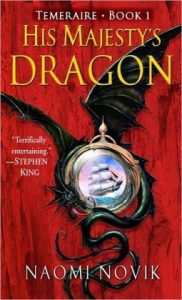 The Temeraire series opens with the capture of Temeraire’s egg by Captain William Laurence and his ship, the HMS Reliant. At the time, Laurence is a naval captain, who looks down upon aviators and their charges. When he is forced into a bond with Temeraire and becomes his captain, his whole life changes — and not initially for the better.
The Temeraire series opens with the capture of Temeraire’s egg by Captain William Laurence and his ship, the HMS Reliant. At the time, Laurence is a naval captain, who looks down upon aviators and their charges. When he is forced into a bond with Temeraire and becomes his captain, his whole life changes — and not initially for the better.
The first book follows the struggles of Laurence and Temeraire as they become members of His Majesty’s Aerial Corps, learn how to work together, and navigate the challenges of their new position. I fell in love with the series very quickly, thanks to the first book and its cast of characters: Lieutenant Granby, Jane Roland, and the other dragons of the corps.
His Majesty’s Dragon does an exceptional job of setting up the Laurence-Temeraire relationship and the philosophical differences between them. It also really delivers on the promise of aerial combat between dragons, with crews of aviators firing muskets from dragon-back, dropping bombs, boarding one another, and so on. The climactic battles over the English Channel are among my favourites in the whole series — my main complaint is that they’re sometimes missing in later books.
Throne of Jade
Rating: B Tier
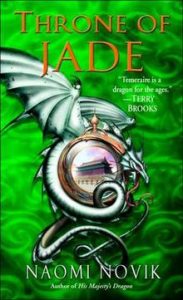
Throne of Jade is the backstory book that sets up Temeraire’s character arc. It is a necessary book, but one that unfortunately ends up being dull for long stretches. The book begins with a lengthy sea journey to China and political maneuvering consumes most of the story, but lacking the stakes you will see in later books.
We discover that Temeraire is a Celestial, a rare breed of dragon found only in China and paired only with Chinese Emperors. His egg was intended as a gift for Napoleon, but now that he has bonded to Laurance, the British must make diplomatic amends — or lose their lucrative trade with China.
There are threats that Laurence and Temeraire will be separated to appease the Chinese. There is conflict between the various factions at the Imperial court. But, in the end, it feels like there is no real doubt that Laurence and Temeraire will succeed, which made the book lose some of its tension for me.
That said, Throne of Jade does advance the broader story in several important ways. It sets up Temeraire’s draconic nemesis and eventual partner to Napoleon, his fellow Celestial Lien. The story also shows how the Chinese live in civilized harmony with dragons and reveals the injustice of the European approach.
So while the book can drag, it feels like an important stopover as we move into the later parts of the series. It’s not my favourite, but I recognize its value to the broader story.
Black Powder War
Rating: S Tier
 In Black Powder War, Laurence and Temeraire return to the war in Europe, travelling back overland from China. En route, they must stop off to pick up the egg of a valuable fire-breathing dragon in the Ottoman Empire, a Kazilik, which has been purchased by the British. This dragon, the female Iskierka, will become Temeraire’s companion and draconic love interest throughout the series.
In Black Powder War, Laurence and Temeraire return to the war in Europe, travelling back overland from China. En route, they must stop off to pick up the egg of a valuable fire-breathing dragon in the Ottoman Empire, a Kazilik, which has been purchased by the British. This dragon, the female Iskierka, will become Temeraire’s companion and draconic love interest throughout the series.
The journey serves as an opportunity to introduce more of the world, outside of Europe and China. Laurence and Temeraire meet and befriend ferals as they cross Central Asia, run into political intrigue at the Ottoman court, and end up at the Battle of Jena in Prussia, where Napoleon wins a great victory with the help of his new ally, Lien.
Like His Majesty’s Dragon, Black Powder War delivers once again on the ‘Napoleonic battles with dragons’ fantasy, which drew me to the series in the first place. The final third of the book builds to a great climax as Temeraire and Laurence attempt to escape after the disastrous defeat of the Prussian army, but the earlier sections carry their own weight. A great bookend for the first section of the series.
Empire of Ivory
Rating: A Tier
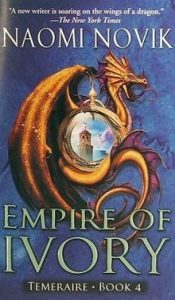 The opening sections of Empire of Ivory introduce a new conflict to the story: the deadly dragon plague, which has decimated the British Corps and prevented them from coming to the aid of the Prussians.
The opening sections of Empire of Ivory introduce a new conflict to the story: the deadly dragon plague, which has decimated the British Corps and prevented them from coming to the aid of the Prussians.
As it turns out, Temeraire has been mysteriously cured of the plague on his passage through the Cape in Throne of Jade. He and Laurence are sent back to Africa to discover the cure. Even as the opening pages of Empire of Ivory introduce this major new conflict, the early parts of the book take some time to develop.
The conflict between the colonial settlers in the Cape and the native Africans dominates the earlier parts of the book, but never goes anywhere. In the end, just as the cure is discovered, Laurence is kidnapped by strange African dragons.
In this way, we are introduced to one of the major powers of the dragon world: the Tswana, an African kingdom jointly ruled by humans and dragons. Angry at the slave trade and determined to take vengeance against Europeans, Temeraire is only narrowly able to escape with Laurence and the others.
Yet when they return home, a fresh dilemma awaits them. The Admiralty wishes to use the plague as a bioweapon against the French — and all other innocent dragons around the world. The high moral scruples of Laurence and Temeraire give them no choice. They betray their country to bring the cure to Napoleon and the rest of Europe.
This decision has enormous implications for the next few books and, indeed, the arc of the entire series. While Empire of Ivory does a great job of setting up this conflict, it lacks a sense of urgency at times. The setting of the Tswana Empire is fascinating and I would’ve loved to see more action there, but instead it feels like a stopover between the Cape and the return to England.
All in all, Empire of Ivory is an enjoyable read, but sometimes feels like it is trying to do too much — at the cost of exploring interesting settings or dynamics.
Victory of Eagles
Rating: A Tier
 Victory of Eagles is a strange book in the series. While it manages to compell throughout, the downward arc of Laurence and Temeraire’s story is never really resolved. The book opens with Temeraire being banished to the breeding grounds, while Laurence is made prisoner to ensure his dragon’s good behaviour — their punishment for surrendering the cure.
Victory of Eagles is a strange book in the series. While it manages to compell throughout, the downward arc of Laurence and Temeraire’s story is never really resolved. The book opens with Temeraire being banished to the breeding grounds, while Laurence is made prisoner to ensure his dragon’s good behaviour — their punishment for surrendering the cure.
Yet while Laurence is censured by his fellow countrymen, Temeraire begins to build a following among the discarded dragons in the breeding ground — the beginnings of a dragon revolution, which he seems to stir up wherever he goes in Europe.
The book kicks off in earnest when Napoleon launches an invasion across the English Channel, eventually capturing the city of London. Laurence is freed and reunited with Temeraire, who has roused the dragons of the breeding grounds to England’s aid — with the promise of food and treasure. Through good behaviour under General Arthur Wellesley and unsavoury tactics, the two manage to drive Napoleon out of English, albeit at a great cost.
What I enjoyed about the Victory of Eagles was the military conflict in the middle section of the story and the final climactic battle. The historical deviation makes sense with the addition of dragons to the picture — Napoleon had no aerial force to attempt a Channel crossing in our world. But the later section of the book drags.
Your sense of injustice against the British establishment (Parliament and the Admiralty) also starts to grow in earnest, but there is maddeningly little satisfaction for our protagonists and the end feels bittersweet. The book is an appropriate midpoint for the journey of Temeraire and Laurence, keeping you invested but unsatisfied, as you move into the second half of the series.
Tongue of Serpents
Rating: C Tier
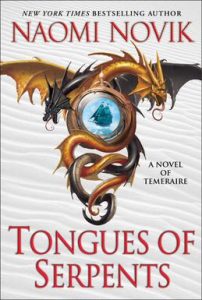 There is no question that Tongue of Serpents was my least favourite book in the series. This book seems intended as the ‘Dark Night of the Soul’ moment for Laurence and Temeraire. Adrift in the Australia colonies and burdened with insufferable superiors, they must deal with warring colonists and petty rebellions. That is, until the dragon eggs that they’re supposed to be guarding are stolen.
There is no question that Tongue of Serpents was my least favourite book in the series. This book seems intended as the ‘Dark Night of the Soul’ moment for Laurence and Temeraire. Adrift in the Australia colonies and burdened with insufferable superiors, they must deal with warring colonists and petty rebellions. That is, until the dragon eggs that they’re supposed to be guarding are stolen.
This event leads Temeraire, Iskierka, and the others on a journey halfway across the Australia outback, where two of the new dragons hatch, and eventually to the north, where they discover a Chinese colony supplied by sea serpents.
What I disliked most about Tongue of Serpents was that it felt like nothing impacted the larger events of the war — and, indeed, it didn’t. This book seems to be about Laurence and Temeraire’s inner journey, in particular, Laurence’s journey to come to peace with his own actions as a traitor.
The journey across the outback is fraught with perils and fascinating at times. New characters are introduced, others grow into their own. Despite this, the stakes felt low and Tongue of Serpents seemed to be simply a stopover on the way to the real action. And as hoped, this is delivered in the final section of the Temeraire series.
Crucible of Gold
Rating: A Tier
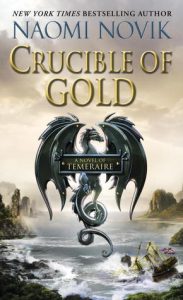 Crucible of Gold opens with Temeraire and his companions departing from Australia, intending to land in Brazil and assist the Portuguese against the Tswana, who have formed a temporary alliance with Napoleon. While sailing across the South Pacific, their transport is lost and the dragons must make a desperate flight for land.
Crucible of Gold opens with Temeraire and his companions departing from Australia, intending to land in Brazil and assist the Portuguese against the Tswana, who have formed a temporary alliance with Napoleon. While sailing across the South Pacific, their transport is lost and the dragons must make a desperate flight for land.
This hair-rising journey lands them temporarily in French captivity aboard a ship bound for the Inca Empire, where Napoleon intends to woo the Inca Empress as bride. Temeraire and crew must escape after being left marooned on an island, in order to reach the Inca capital in time to prevent disaster from occurring.
In the end, Laurence and Temeraire fail and their party must flee in haste from the feathered Inca dragons and reach Brazil. Once there, they are able to arrange an eventual truce between the Tswana and the Portuguese, in exchange for the return of the slaves.
From one escape to the next, Crucible of Gold delivers on the stakes that were missing in Tongue of Serpents. You begin to see the work of Temeraire come to fruition, as he builds common ground between foreign dragons (like the Tswana), and takes his first step toward defeating Napoleon.
Novik’s depictions of the Inca Empire provides a fascinating backdrop to the action. This is where the Temeraire series is at its best, through the exploration of different cultures integrating the presence of dragons. However, the action continues to jump around — without a clear sense of building to something.
Part of the charm of Temeraire is the way it jumps from one setting to the next. But this trend can also make conflicts feel irrelevant at times — and Crucible of Gold is guilty of this, for all its merits.
Blood of Tyrants
Rating: S Tier
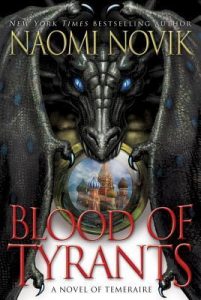 Building on the momentum of Crucible of Gold, Blood of Tyrants was my favourite book in the Temeraire series to date. Despite featuring three distinct set-pieces in Japan, China, and Russia, the conflict in Blood of Tyrants builds in a satisfying way to a historic confrontation in Moscow, paving the way for Napoleon’s eventual defeat.
Building on the momentum of Crucible of Gold, Blood of Tyrants was my favourite book in the Temeraire series to date. Despite featuring three distinct set-pieces in Japan, China, and Russia, the conflict in Blood of Tyrants builds in a satisfying way to a historic confrontation in Moscow, paving the way for Napoleon’s eventual defeat.
The book’s opening raises the stakes immediately. En route back to China, Laurence and Temeraire’s ship is wrecked on the coast of Japan. Laurence is lost at sea and finds himself a prisoner on Japanese soil, unable to remember anything of the last eight years. What follows is a desperate attempt by Laurence to escape Japanese authorities — before the others leave him behind.
From Japan to the Chinese Imperial court, where rebellion is brewing again. After settling matters, Temeraire heads west at the head of three hundred Chinese dragons to rescue the Russians from the army that Napoleon is leading to Moscow.
The troublesome character of the Russians (and Napoleon’s own ingenious response) makes victory far from certain, but you begin to see Temeraire step into his own as leader. At the same time, as Laurence’s memory returns, he begins to discard his former prejudice and embrace the better sensibilities of his dragon — at least, some of the time.
While there is no victorious conclusion to the Russian campaign, Blood of Tyrants sets the stage for the climactic chapter in spectacular fashion. Napoleonic battles return to the forefront of the story. Laurence and Temeraire each take steps toward those satisfying transformations, which we’ve been awaiting since the early installments of the series. All in all, Blood of Tyrants delivers.
League of Dragons
Rating: A Tier
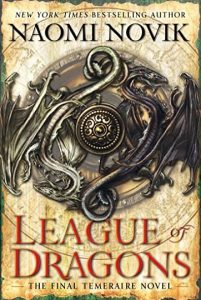 The final book in the Temeraire series picks up where Blood of Tyrants left off — in the cold of the Russian winter. Napoleon in retreat, but he has left chaos behind him. Temeraire makes a final desperate attempt to capture him, but is thwarted. The emperor has already fled.
The final book in the Temeraire series picks up where Blood of Tyrants left off — in the cold of the Russian winter. Napoleon in retreat, but he has left chaos behind him. Temeraire makes a final desperate attempt to capture him, but is thwarted. The emperor has already fled.
More than any other book in the series, dragon politics takes centre stage in the aptly-named League of Dragons, which is clearly the trajectory that Novik had planned. Starting with Temeraire’s visit to China in Throne of Jade and building steam in the middle trio (especially Victory of Eagles), we begin to see the issues with the European rule over dragons.
In League of Dragons, Temeraire’s efforts to make draconic friendships around the world comes home to roost — and his previous good deeds see him achieve his final victory. But before that can happen, there are other crises. A precious egg is stolen and Napoleon has a few other tricks up his sleeve.
I really wanted to see League of Dragons end the series in an exceptional way — and the climax wasn’t bad, by any means. It hit all the right notes. However, the journey there felt messy at times. As is typical of the series, there was a lot of jumping around from place to place. Things happened that felt unnecessary or tangential to the main conflict, and I was often left wondering why certain conflicts were included
When the final battle against Napoleon arrived, there were parts of it that felt almost anticlimactic. I wanted a bigger fight, a more decisive final moment, where victory and defeat teetered in the balance. But to be honest, the ending never felt in any doubt — not because Napoleon wasn’t a worthy adversary, but because it didn’t seem like the characters were afraid enough of him.
Final Thoughts
In the end, the climax of the Temeraire series is the unification of the dragons — the various ferals, the different allied forces, and foreign powers like the Tswana and the Inca — not the defeat of Napoleon. Uniting dragons always was the emotional heart of the story. After it is achieved, beating Napoleon feels like an afterthought.
This is one of the strange tensions of the series. It often feels like Temeraire and Laurence’s arc is to defeat Napoleon, but it isn’t — in the end. The story is about the unification of dragons, them taking the world stage alongside humans, and the Napoleonic wars are the framing device for that.
For some people, this framing might be fine. For me, I felt misled, at times. Or pulled in two directions. I wanted more Napoleonic battles, or more politics. Divided between the two, I was sometimes left unsatisfied by both.
To be clear, Temeraire is a great series. The characters are wonderful and vivid. Their emotional conflict between the two protagonists carries the series. Novik imagines a variety of intriguing settings and there is rarely a boring moment. That said, the end left me wanting.
I wanted the ending to say something more about human (or perhaps draconic) nature. I wanted to see Napoleon’s defeat recast to reflect Temeraire’s moral triumph. And neither happened, but perhaps that is Novik’s message, after all.
Temeraire’s victory was messy, and due more to the work of his allies than his own actions. Perhaps there’s some truth in that. Regardless, I greatly enjoyed the journey and I would strongly recommend it to any lovers of character-driven fantasy.
Have you read Temeraire? Do you agree with my take on the series or think that I’ve got it all wrong? Please feel free to leave a comment below — I always enjoy some good discussion on the subject.